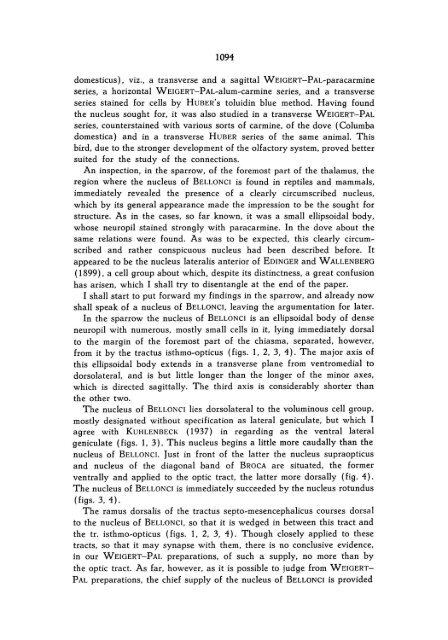The nucleus of BELLONCI in birds - DWC
The nucleus of BELLONCI in birds - DWC
The nucleus of BELLONCI in birds - DWC
Create successful ePaper yourself
Turn your PDF publications into a flip-book with our unique Google optimized e-Paper software.
1094<br />
domestieus), viz., a transverse and a sagittal WEIGERT-PAL~paracarm<strong>in</strong>e<br />
series, a horizontal WEIGERT-PAL~alum~carm<strong>in</strong>e series, and a transverse<br />
series sta<strong>in</strong>ed for cells by HUBER's toluid<strong>in</strong> blue method. Hav<strong>in</strong>g found<br />
the <strong>nucleus</strong> sought for, it was also studied <strong>in</strong> a transverse WEIGERT-PAL<br />
series, countersta<strong>in</strong>ed with various sorts <strong>of</strong> carm<strong>in</strong>e, <strong>of</strong> the dove (Columba<br />
domestica) and <strong>in</strong> a transverse HUBER series <strong>of</strong> the same anima!. This<br />
bird, due to the stronger development <strong>of</strong> the olfactory system, proved better<br />
suited for the study <strong>of</strong> the connections.<br />
An <strong>in</strong>spection, <strong>in</strong> the sparrow, <strong>of</strong> the foremost part <strong>of</strong> the thalamus, the<br />
region where the <strong>nucleus</strong> <strong>of</strong> <strong>BELLONCI</strong> is found <strong>in</strong> reptiles and mammais,<br />
immediately revealed the presence <strong>of</strong> a clearly circumscribed <strong>nucleus</strong>,<br />
whieh by its general appearance made the impression to be the sought for<br />
structure. As <strong>in</strong> the cases, so far known, it was a small ellipsoidal body,<br />
whose neuropil sta<strong>in</strong>ed strongly with paracarm<strong>in</strong>e. In the dove about the<br />
same relations were found. As was to be expected, this clearly circum~<br />
scribed and rather conspicuous <strong>nucleus</strong> had been described before. It<br />
appeared to be the <strong>nucleus</strong> lateralis anterior <strong>of</strong> EDINGER and WALLENBERG<br />
(1899), a cell group about whieh, despite its dist<strong>in</strong>ctness, a great con fusion<br />
has arisen, whieh I shall try to disentangle at the end <strong>of</strong> the paper.<br />
I shall start to put forward my f<strong>in</strong>d<strong>in</strong>gs <strong>in</strong> the sparrow, and already now<br />
shall speak <strong>of</strong> a <strong>nucleus</strong> <strong>of</strong> <strong>BELLONCI</strong>, leav<strong>in</strong>g the argumentation for later.<br />
In the sparrow the <strong>nucleus</strong> <strong>of</strong> <strong>BELLONCI</strong> is an ellipsoidal body <strong>of</strong> dense<br />
neuropil with numerous, mostly small cells <strong>in</strong> it, ly<strong>in</strong>g immediately dorsal<br />
to the marg<strong>in</strong> <strong>of</strong> the foremost part <strong>of</strong> the chiasma, separated, however,<br />
from it by the tractus isthmo~optieus (figs. I, 2, 3, 4). <strong>The</strong> major axis <strong>of</strong><br />
th is ellipsoidal body extends <strong>in</strong> a transverse plane from ventromedial to<br />
dorsolateraI. and is but little longer than the longer <strong>of</strong> the m<strong>in</strong>or axes,<br />
whieh is directed sagittally. <strong>The</strong> third axis is considerably shorter than<br />
the other two.<br />
<strong>The</strong> <strong>nucleus</strong> <strong>of</strong> <strong>BELLONCI</strong> lies dorsolateral to the volum<strong>in</strong>ous cell group,<br />
mostly designated without specifieation as lateral genieulate, but whieh I<br />
agree with KUHLENBECK (1937) <strong>in</strong> regard<strong>in</strong>g as the ventral lateral<br />
geniculate (figs. I, 3). This <strong>nucleus</strong> beg <strong>in</strong>s a little more caudally than the<br />
<strong>nucleus</strong> <strong>of</strong> <strong>BELLONCI</strong>. Just <strong>in</strong> front <strong>of</strong> the latter the <strong>nucleus</strong> supraopticus<br />
and <strong>nucleus</strong> <strong>of</strong> the diagonal band <strong>of</strong> BROCA are situated, the former<br />
ventrally and applied to the optie tract, the latter more dorsally (fig. 4).<br />
<strong>The</strong> <strong>nucleus</strong> <strong>of</strong> <strong>BELLONCI</strong> is immediately succeeded by the <strong>nucleus</strong> rotundus<br />
(figs. 3, 4).<br />
<strong>The</strong> ramus dorsalis <strong>of</strong> the tractus septo~mesencephalieus courses dorsal<br />
to the <strong>nucleus</strong> <strong>of</strong> <strong>BELLONCI</strong>, so that it is wedged <strong>in</strong> between this tract and<br />
the tr. isthmo~optieus (figs. I, 2, 3, 4) . Though closely applied to these<br />
tracts, so that it may synapse with them, there is no conclusive evidence,<br />
<strong>in</strong> our WEIGERT-PAL preparations, <strong>of</strong> such a supply, no more than by<br />
the optie tract. As far, however, as it is possible to judge from WEIGERT<br />
PAL preparations, the chief supply <strong>of</strong> the <strong>nucleus</strong> <strong>of</strong> <strong>BELLONCI</strong> is provided
















